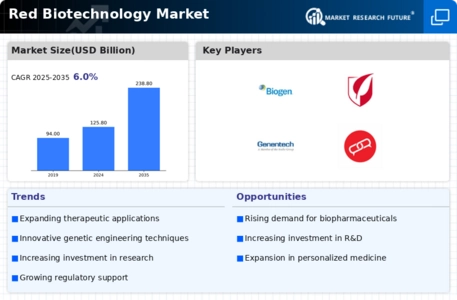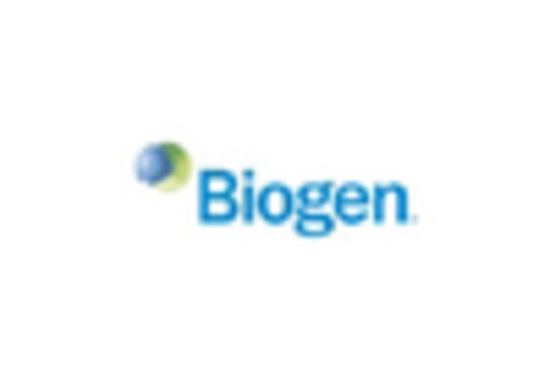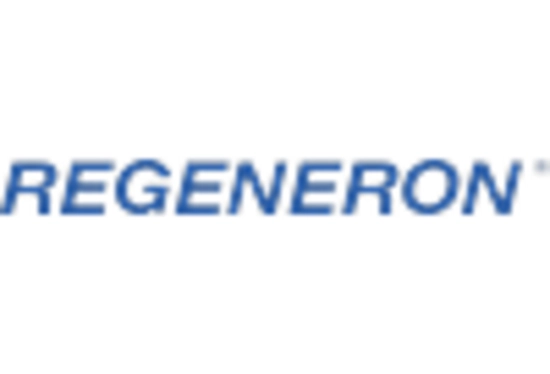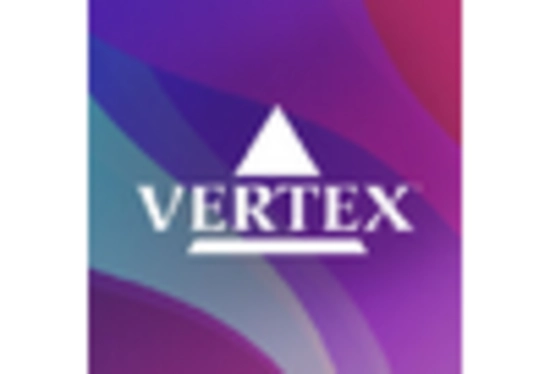Growing Focus on Preventive Healthcare
The Red Biotechnology Market is witnessing a paradigm shift towards preventive healthcare, which is reshaping the demand for biotechnological solutions. As awareness of health and wellness increases, there is a growing preference for therapies that not only treat diseases but also prevent them. This trend is driving the development of vaccines and diagnostic tools that leverage biotechnological advancements. The market for preventive healthcare solutions is expected to expand significantly, with estimates suggesting a growth rate of over 10% annually. Consequently, the Red Biotechnology Market is likely to capitalize on this shift, as companies innovate to create products that align with the preventive healthcare model.
Increasing Demand for Biopharmaceuticals
The Red Biotechnology Market is experiencing a notable surge in demand for biopharmaceuticals, driven by the rising prevalence of chronic diseases and genetic disorders. As healthcare systems evolve, there is a growing emphasis on innovative therapies that can provide targeted treatment options. According to recent data, the biopharmaceutical sector is projected to reach a valuation of over 500 billion USD by 2026, indicating a robust growth trajectory. This demand is further fueled by advancements in research and development, which are enabling the creation of more effective and safer therapeutic agents. Consequently, the Red Biotechnology Market is positioned to benefit significantly from this trend, as companies strive to meet the increasing needs of patients and healthcare providers alike.
Regulatory Support and Funding Initiatives
The Red Biotechnology Market is benefiting from increased regulatory support and funding initiatives aimed at fostering innovation. Governments and regulatory bodies are recognizing the potential of biotechnology in addressing pressing health challenges. As a result, there has been a rise in grants and funding programs designed to support research and development in this sector. For example, various initiatives have been launched to streamline the approval process for biopharmaceuticals, thereby encouraging investment in the Red Biotechnology Market. This supportive environment is likely to stimulate growth, as companies are more inclined to invest in research and bring new products to market, ultimately enhancing the overall landscape of biotechnology.
Technological Innovations in Biotechnology
Technological advancements are playing a pivotal role in shaping the Red Biotechnology Market. Innovations such as CRISPR gene editing, synthetic biology, and advanced bioinformatics are revolutionizing the way biotechnological products are developed and manufactured. These technologies not only enhance the efficiency of research processes but also reduce costs associated with drug development. For instance, the integration of artificial intelligence in drug discovery is streamlining the identification of potential therapeutic candidates, thereby accelerating time-to-market. As a result, the Red Biotechnology Market is likely to witness an influx of novel products and solutions that cater to diverse medical needs, ultimately improving patient outcomes.
Rising Investment in Biotechnology Startups
Investment in biotechnology startups is on the rise, significantly impacting the Red Biotechnology Market. Venture capital firms and private equity investors are increasingly recognizing the potential of innovative biotechnological solutions to address unmet medical needs. This influx of capital is enabling startups to accelerate their research and development efforts, leading to the emergence of groundbreaking therapies and technologies. Recent reports indicate that investment in biotech startups has reached record levels, with billions of dollars being funneled into the sector. As these startups bring novel products to market, the Red Biotechnology Market is poised for substantial growth, driven by the creativity and agility of these emerging companies.


















Leave a Comment